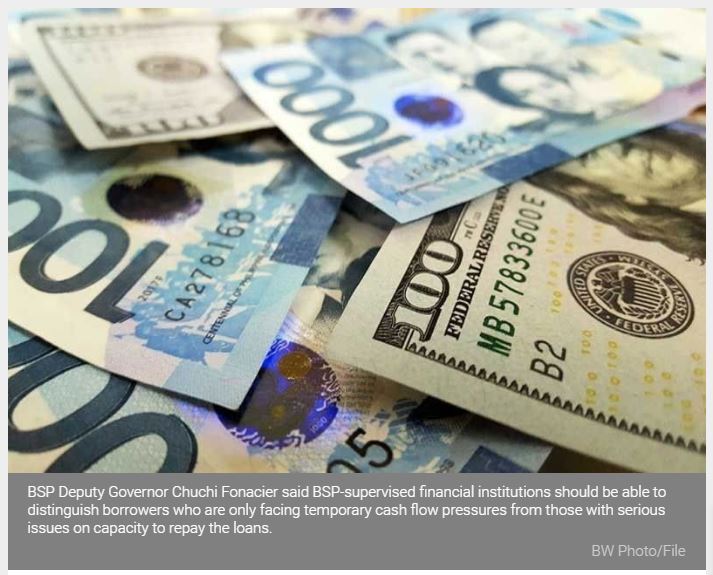Philippines: Banks told to improve borrower assessment
In anticipation of higher loan defaults
MANILA, Philippines — The Bangko Sentral ng Pilipinas (BSP) has ordered banks to conduct a comprehensive assessment of the impact of the COVID-19 pandemic on the industry’s loan portfolio in anticipation of higher defaults.
BSP Deputy Governor Chuchi Fonacier said BSP-supervised financial institutions should be able to distinguish borrowers who are only facing temporary cash flow pressures from those with serious issues on capacity to repay the loans.
Fonacier said that banks should apply the same level of prudence in assessing the financial capacity of borrowers and in making credit decisions as the pandemic has affected the cash flows of households and businesses.
“Decisions to grant new loans or to modify the terms of existing loans should be based on sound assessment of the financial profile of the borrowers,” Fonacier said.
The regulator said BSP-supervised financial institutions should establish sound criteria in differentiating borrowers with temporary cash flow pressures from those who are considered as credit impaired.
It also said the grant of relief measures in the form of payment holidays, loan payment deferrals, and other similar schemes that effectively moves the payment due date of the loan should not automatically be considered as an indicator of significant increase in credit risk.
According to the BSP, the uncertainties caused by the COVID-19 pandemic posed significant challenges in implementing the expected credit loss methodology under the Philippine Financial Reporting Standards (PFRS) 9.
This is because the existing assumptions, scenarios and forecasts being used for expected credit loss provisioning may no longer hold in this current environment due to the implementation of the mandatory grace period under Republic Act 11469 or the Bayanihan to Heal as One Act and the relief measures granted by the BSP.
To address this, the Monetary Board issued Resolution 967 on July 30, approving the supervisory expectations on the measurement of expected credit losses and the treatment of regulatory relief measures amid the health pandemic.
Fonacier said the supervisory expectations provide that institutions that avail themselves of the regulatory relief measures to exclude eligible loans from past due and non-performing classifications and to stagger the booking of allowance for credit losses shall continue to report actual past due and non-performing loans and allowance for credit losses in the financial reporting package and the capital adequacy ratio reports.
“This is to facilitate the generation of industry statistics and provide the BSP with information on the true health of the banking system,” Fonacier said.
She said the adjusted past due, non-performing loans (NPLs) and allowance for credit losses of the bank after applying the relief measures should be used in supervisory assessments and in crafting the supervisory plan for the BSP supervised financial institutions.
For one, the adjusted past due and NPLs as well as allowance for credit losses after applying the relief measures should be used for purposes of determining compliance with the minimum capital adequacy ratio, liquidity coverage ratio, net stable funding ratio as well as with the reserve requirements, among other prudential requirements.
Latest data from the BSP showed the industry’s NPL ratio rose for the fifth straight month to hit a five-year high of 2.43 percent in May from 2.31 percent in April amid the sharp rise in past due and restructured loans.
Based on stress testing exercises, the regulator expects higher NPL over the short run but not as high as the peak during the Asian financial crisis in 1997 and 1998. The NPL ratio ranged from three to 3.4 percent in the first half of 1997 and peaked at 18.7 percent in 2001.
Source: https://www.philstar.com/business/2020/08/05/2032912/banks-told-improve-borrower-assessment


 English
English




